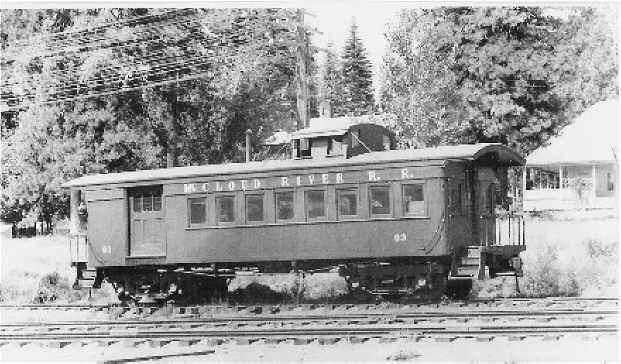|
McCloud Rails History: Part I
|
|||||||||||||||||||||||||||||
|
|
|||||||||||||||||||||||||||||
The northern regions of California are dominated by the presence of Mt. Shasta, located on the southern end of the Cascade Mountain Range that extends from northern California through Central Oregon and into Washington. The mountain peak stands at 14,162 feet above sea level, a full 10,000 feet higher than the surrounding countryside. The same volcanic forces that created the mountain have also molded the surrounding countryside into what it is today- a broken land of recent and ancient lava flows with a scattering of cinder cones and smaller peaks.
Some of the land is still covered by barren lava flows recent enough that little if any vegetation is found on them. However, in areas where time has converted weathered volcanic rock mixed with volcanic ash into productive soils, vast forests are found. The primary species of trees found in these forests are Ponderosa Pine (Pinus ponderosa0, Douglas Fir (Pseudotsuga menzesii), Incense Cedar (Calocedrus decurrens), White Fir (Abies concolor), and Sugar Pine (Pinus lambertiana). The first railroad construction in the area was completed by the Central Pacific Railroad (builder of the western portion of the Transcontinental Railroad). The Central Pacific was building northward towards Oregon, destined to meet with an affiliated company that was building south from Portland. Construction north through the Central Valley of California proceeded easily enough. Rails reached Redding, CA in August of 1872, where construction halted for twelve years while the affairs of the Oregon road were meshed out. After a lengthy period of re-organization, the Oregon road resumed construction south from Roseburg, OR in 1881. Once good progress had been made, the Central Pacific resumed construction northward from Redding in August of 1883. Delta, CA was reached on 1 September 1884, where worked stalled for another year. Northbound construction resumed in September 1885. By the end of 1886 rails stretched north up the Sacramento River Canyon through Dunsmuir to a new townsite laid out in the Strawberry Valley on the southwest flank of Mt. Shasta that was named Sisson in honor of long-time area resident Justin Hinckley Sisson. Construction continued northward until the southbound railroad was met in Ashland, OR. The last rail connecting Portland with San Francisco was spiked down in Ashland on 16 December 1887.
Construction of the railroad consumed enormous quantities forest products, and many logging and lumber companies sprang up along the line to meet the demand. The transportation to markets for forest products ensured survival of many of these companies beyond the railroad construction phase. However, the railroad was built within the tight confines of the Sacramento River Canyon through most of the area, limiting the amount of logging area available. New railroads built into fresh stands of timber were the answer, but the steep walls of the canyon limited the directions that such railroads could go.
The Squaw Valley stretched out from the southeast flank of the great mountain, and it contained vast stands of trees. The McCloud River wound it’s way through part of the valley, flowing from the mountains to the east westward to a confluence with the Sacramento River north of Redding. A 1000-foot high spur of Mt. Shasta separated Squaw Valley from the Strawberry Valley and the new railroad. Timber was cheap on the Squaw Valley side of the mountain, but there was no easy transportation into or out of the valley. A man named Friday George was the first to see opportunity in the Squaw Valley, and he purchased vast stands of timber through the valley. Mr. George built a small sawmill and started a small town on the banks of a small tributary to the McCloud River. The transportation issue was solved by building a rough road over the summit to the general area of Sisson. A steam-powered tractor engine was acquired to move freight over the hill. However, the entire venture cost far more than expected, and Friday George was forced into bankruptcy. The Bank of Shasta County took over, and an auction was held on 10 June 1895. The successful bidders were a pair of local businessmen named William M. Van Arsdale and George Scott. |
|||||||||||||||||||||||||||||
|
|
|||||||||||||||||||||||||||||
 |
|||||||||||||||||||||||||||||
| Photo depicts |
|||||||||||||||||||||||||||||
|
|||||||||||||||||||||||||||||